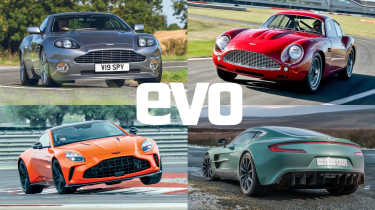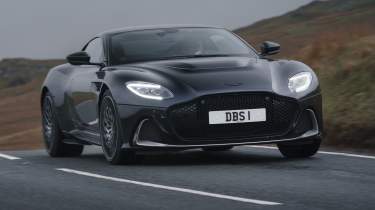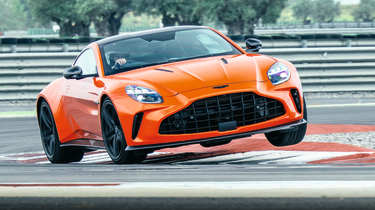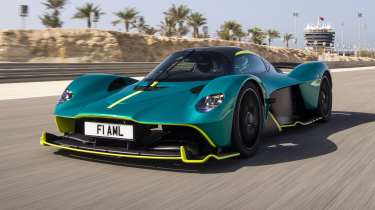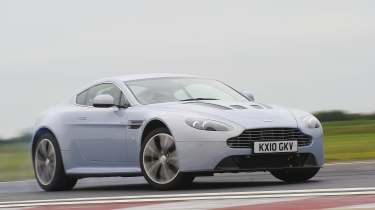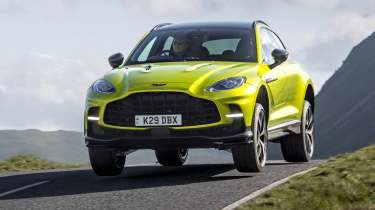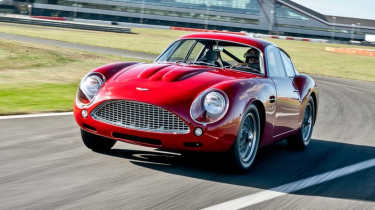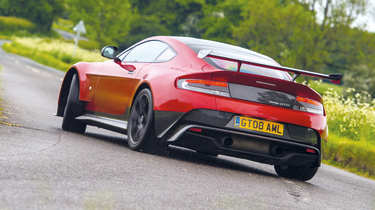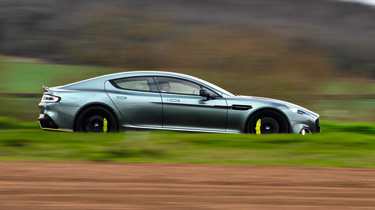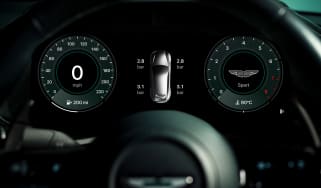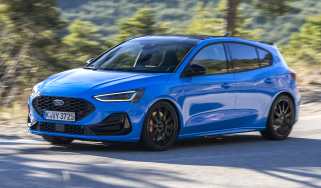Best Aston Martins – the greatest hits from Britain’s sports car icon
Aston Martins often trade heavily on emotion, but there are a few that are revered by the evo team that are as beautiful to drive as they are to look at. These are Gaydon’s finest models of all time
Aston Martin, often the underdog in comparison to its Modenese rivals, has traditionally traded on treading the fine line between sports cars, supercars and grand tourers. Do they always dominate group tests or the cold objective world of spec sheets? Rarely, but there’s not a long-serving evo contributor that hasn’t fallen in love with an Aston or three over the years.
Today, the marque has spread its proverbial wings further than ever, offering everything from the Valkyrie, a Le Mans hypercar with number plates, to the DBX707, a super SUV that’ll stomp some supercars around Anglesey before heading off to do the school run. But it is the DB12, the Vantage and soon the Vanquish, that resolutely endure as the core lineup of front-engined, rear driven beauties that the traditional ‘Aston’ silhouette is survived by.
> Aston Martin Valhalla spied testing: 998bhp Ferrari rival gears up for launch
Speaking of the Aston Martin Vanquish, following in the direct footsteps of the exceptional DBS 770, the mind wanders to the sprawling upper echelons of the greatest Aston Martins that we all hope it’ll have the chops to join. These are the best Aston Martins evo has driven, that the new Vanquish has to live up to.
Aston Martin DBS 770 (2023)
The DBS Superleggera, or just the DBS as it eventually became known, like many of those Palmer-era cars, had an air of incompletion about it. It epitomised the brawn and beauty balance that only Aston seems to master but without the absolute last tenth of chassis finesse, of rear axle control and of transparency, that makes a performance car truly spectacular. But Aston has a habit of iterating, reaching close to perfection often at the last minute and only for a limited few. And so to the DBS 770 Ultimate, we look; the run-out special that he standard DBS – undoubtedly a great car in its own right – always should have been.
Yes, there’s more power – a bump up 44bhp to 759bhp to be precise – but the DBS was never short on that. It’s the subtle stuff under the skin that ties it all together. With its stronger front subframe and solidly mounted steering column, the DBS 770 ups the feel and engagement with the driver, while the updated dampers give it a hair more control of its own mass over a road. John Barker highlighting that the ‘sport’ setting for the suspension is the sweet spot on the road, in a world where many performance cars have to be in ‘comfort’ to be tolerable, probably says all you need to know about how deftly executed the DBS 770 was. A shame then, that just 499 of them were made in total. We hope the Vanquish picks up where the DBS 770 left off.
Aston Martin Vantage (2024)
The DBS 770 was sort of the spark to start a blaze of great form from Gaydon, carrying well into its new generation of so-called super tourers and sports cars, first with the DB12 and then, the Vantage. As we found on the launch of the updated car earlier this year, the new Aston Martin Vantage is Gaydon's sports car debug, offering balance, communication, response and performance, in the finely-judged measures and with a level of coalescence Aston lovers have always dreamed it could muster some day. Of course, the tradeoff is that the new Vantage isn’t quite as refined a continent crosser as its softer-edged grand touring stablemates are.
You could argue a bump in power from 503bhp to 656bhp might seem overkill, too. Yet it only speaks to Aston’s ambitions for the Vantage to graduate from Carrera S-fighting middleweight to Turbo S-busting heavyweight; from sports car to supercar-adjacent. The rest of its composition, from the chassis to the steering, to the balance, is complemented by the power rather than overwhelmed by it. It’s a masterclass.
Aston Martin Vanquish S (2004)
The original Aston Martin Vanquish of 2001 was the genesis for Aston as we know it today. While the DB7 pioneered the broad silhouette and Ian Callum-penned proportion-lead beauty, the Vanquish brought the revolutionary extruded aluminium chassis structure to bear. But even with that spectacular V12, innovative underpinnings and carbon kevlar bodywork that clothed it, as is so often the case with Aston, there was more potential left on the table.
Enter Vanquish S in 2003, with a bump in power to 520bhp from 460bhp and a glob of much-needed speed and response for the still-shonky automated manual transmission. But it was the subtle tweaking of the steering and suspension that allowed the Vanquish S to come into its own. Was it a car that ever really became all it could be? Probably not. But it stands broad-shouldered in the pantheon of Aston’s super GTs.
Aston Martin Valkyrie (2023)
Could anyone in 2001 have imagined anything like the Aston Martin Valkyrie would ever exist, let alone that it would come from Aston Martin and in less than 20 years? With a Formula 1 mindset from conception to construction, with a screaming 11,100rpm V12 heart courtesy of Cosworth and Adrian Newey-honed aerodynamics, it’s not really like any other production car yet made.
Its sophistication and the sheer breadth of its capabilities do limit how dynamically endearing it is in the traditional sense. But the engine, the looks, the sheer speed it can generate, the dedication to the concept, and the pure shock value are utterly undeniable. It was never going to be anything other than a sheer monolith in the history of Aston Martin.
Aston Martin V12 Vantage (2009)
Big engine, little car. It’s a formula that produces cars that are almost always huge on charm but often lacking a little in balance. Not so with the V12 Vantage. Shoehorning the 5.9-litre V12 – in rorty 510bhp spec as in the Aston Martin DBS – under that bonnet can’t have been the work of a moment or of meagre minds, but somehow they made it work and crucially, made the whole car work around it.
There’s muscle car character, yes, but it’s not belligerent, certainly not in the company of what were some of its key rivals at the time like the Corvette ZR1 and Porsche 911 GT2. We hailed it as the best car Aston made at the time, for the way it blended brutality and beauty, pugnaciousness and poise. One of the most beautiful, exciting and engaging cars of its day and a worthy north star to which we hope Aston looked when shaping the character of the new Vanquish.
Aston Martin DBX707 (2024)
When Aston Martin announced it was to join the SUV furore there must have been more than a few concerned looks exchanged between evo readers. But with promises of a sophisticated, bespoke aluminium structure and the same focus on dynamics, performance and style that you’d expect of any other car to wear the wings, there was hope against the at-a-glance odds, that this would be a proper Aston. It wasn’t unfounded, with the DBX impressing right from the off, albeit with room to grow and improve. The Aston Martin DBX707 was the iteration that made the DBX all it should be.
Even among stiff competition from Porsche, Mercedes-AMG, BMW and now even Range Rover with the excellent Range Rover Sport SV, the DBX707 might just be the pick of the pack. Its dynamic character is tantamount to witchcraft, dispensing with that 2245kg weight and high driving position to deliver a natural, collaborative, even playful driving experience. Compared to the standard DBX, the wet-clutch nine-speed Speedshift gearbox is much more up to the job of hustling between cogs. There’s also an electronically-locking rear diff that can take all of the DBX’s 663lb ft if the systems decree it necessary, and make sure the right wheels are spinning to let the tail run wide under excess power. As for the damping? Only the Ferrari Purosangue – shod with trick Multimatic dampers and configurable to double the price – can bloody its nose for body control. The cherry on the cake is Aston recently gave the DBX707’s interior a DB12 and Vantage-style overhaul. It really is unironically one of the best cars Aston Martin has ever made. Blasphemy, we know…
Aston Martin DB4 GT Continuation (2021)
If any Aston could be described as being at the opposite end of the spectrum to the marque’s brutish super SUV, it’s this, the DB4 GT Continuation. Quite literally an old car made new, the DB4 GT Continuation is one of a run of cars made to be sold alongside the DBS GT Zagato within the DBZ Centenary collection. Just 19 pairs of cars were built to mark 100 years of the Italian carrozzeria, with the DBS the modern roadgoing portion and the DB4 the Newport Pagnell-built, panel-beaten track-only classic portion.
And therein lies the genius of the DB4 GT Zagato, for it puts those 19 buyers back in touch with the joys of historic motoring, reminding us of just what a joy a racing car from the golden era is to drive. It’s a barrage of undiluted sensations, unfiltered and unfettered by adjustable systems, meddling software and heavy-duty hardware. It’s a car that demands entirely alien inputs to those of a modern performance car but still, that they are applied with forethought, precision and delicacy. This is a car you need to find a rhythm with, to unlock the throttle-steerable rear end, to fully exploit the steering and to push those high-sidewall tyres into their window. Patience, re-education and appreciation for what the DB4 GT Zagato is are limitlessly rewarded. Would the Hollywood star that is the DB5 be the pick of most as an all-time great Aston Martin? Probably. But for those with evo sensibilities, the DB4 GT Zagato embodies what we want in an old Aston.
Aston Martin One-77 (2009)
On the reveal of the Valkyrie project and throughout its gestation, there was an underlying conversation about what an Aston Martin should be. For diehards, nothing other than a front-engined, rear-driven super GT deserves to wear the wings and as such an Aston Martin hypercar shouldn’t be anything like the Valkyrie. It should be more like the Aston Martin One-77 of a decade earlier.
A Cosworth-fettled V12 and carbonfibre chassis it might have, but it sets that howling 750bhp, 7.3-litre mill ahead of the passenger cell – albeit still in a front-mid position partly under the endless sprawling bonnet and partly under the windscreen and dashboard. To look at the One-77 is Aston Martin as you know it, exaggerated in every direction. It’s not got the Valkyrie’s billowing venturi tunnels and porous carbon bodywork to bully the air into downforce development. In fact, the bodywork of the One-77 is aluminium. But it’s wider, lower, with broader hips, a longer bonnet and a bigger mouth than any other traditional Aston Martin.
At the back, the Aston ‘wing’ lights are width-spanning LED-shod single element – very ahead of its time – while the full hatch and decent boot of ‘normal’ Astons made way for an opening rear window that reveals a boot full of exposed suspension and bracing, albeit in a bed of sumptuous leather. As above; Aston as you know it, in the extreme.
The evo team discovered as much was true about the driving experience during a two-part test over a decade ago, when we exposed the One-77 to both a track drive around Millbrook and a tour through North Wales. There’s an extremeness to it – the way the clutch slips and the car jerks at low speeds is almost race car-like, just like the sound and response of the V12 engine. Only most race cars don’t have half the power of Aston’s hyper GT or, on the flip side, a cabin glazed in leather, Bluetooth connectivity or a Bang & Olufsen stereo. It’s a visceral challenge by all accounts, that you undertake from a leather-bound, carbon and aluminium-trimmed boudoir. We told you, it’s Aston Martin triple distilled.
Aston Martin Vantage GT8 (2016)
Starting the job of sending the VH platform out with a bang was the aim of the game in 2015 when Aston Martin revealed its widened, bewinged pair of Vantages. But while the Vantage GT12 had the majesty of that 5.9-litre naturally-aspirated V12, it was more a 911 GT2 equivalent, than the 911 GT3-fighter that Aston tried to make it out as. It was the tighter, taughter, Vantage GT8 that followed, with its option of a manual gearbox, that established itself as the true driver's car of the pair and secured itself a spot on evo Car of the Year in 2016.
It was a divisive thing among the team at the time, with the loud looks and louder noise not hitting the mark for some. But it demonstrated a character and commitment to the joy of driving that eventually unified almost all in reverence of it. The perfectly calibrated brakes lend confidence to lean on them, while the passive damping setup comes alive at speed and serves diligently as a middle man for your senses and the road.
The aero addenda, aural aggression of the 440bhp 4.7-litre V8 and 100kg drop in kerb weight sell a 911 GT3 rival and it kind of is, in the traditional 997-and-older sense. This is a characterful, challenging fast road car with braking and suspension hardware to hold up to track abuse, if not an appointment for record-breaking lap times. As stated in our review, its placing of ninth says more about the strength of the opposition in eCoty that year, than the weakness of the GT8. It’s an Aston for the ages that heads a family of exceptional sports GTs.
Aston Martin Rapide AMR (2019)
The Aston Martin Rapide was never a car totally dedicated to its apparent purpose. Sitting in the range as the only car with four doors and four proper seats, it was often ridiculed by comparison to obvious rivals for not offering anything like the space and comfort that it really ought to have when four up.
The same is the case with the run-out special, Aston Martin Rapide AMR. But evo isn’t about four-door practicality, it’s about the thrill of driving and when it comes to how an Aston Martin should go about the job of delivering that, the Rapide in its puffed-up, pugnacious run-out AMR form, is by all accounts a tonic. The true last hurrah of the VH platform, winding up its 210-car production run in 2019, the Rapide AMR is a Rapide S that’s been through dynamic finishing school, with a 10mm drop in ride height, recalibrated adaptive dampers and a tightened chassis. The 5.9-litre V12 in one of its most potent 595bhp forms brings it all to life and is made eminently usable through the preferable ZF eight-speed transmission – remember, the Vantage GT12 was hobbled with the Sportshift single-clutcher.

